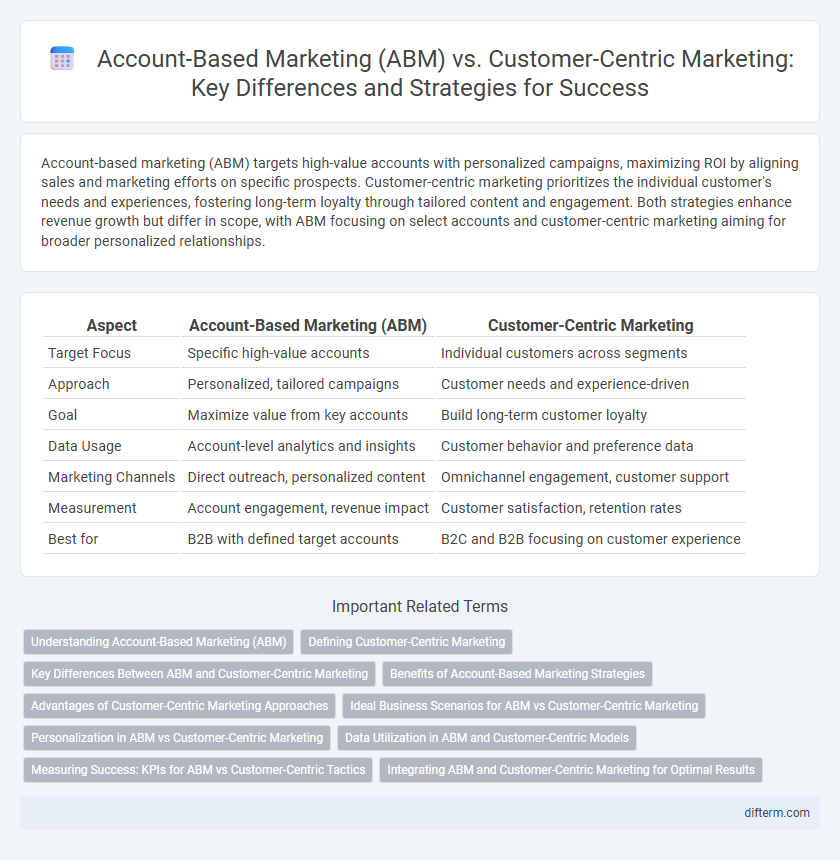Account-based marketing (ABM) targets high-value accounts with personalized campaigns, maximizing ROI by aligning sales and marketing efforts on specific prospects. Customer-centric marketing prioritizes the individual customer's needs and experiences, fostering long-term loyalty through tailored content and engagement. Both strategies enhance revenue growth but differ in scope, with ABM focusing on select accounts and customer-centric marketing aiming for broader personalized relationships.
Table of Comparison
| Aspect | Account-Based Marketing (ABM) | Customer-Centric Marketing |
|---|---|---|
| Target Focus | Specific high-value accounts | Individual customers across segments |
| Approach | Personalized, tailored campaigns | Customer needs and experience-driven |
| Goal | Maximize value from key accounts | Build long-term customer loyalty |
| Data Usage | Account-level analytics and insights | Customer behavior and preference data |
| Marketing Channels | Direct outreach, personalized content | Omnichannel engagement, customer support |
| Measurement | Account engagement, revenue impact | Customer satisfaction, retention rates |
| Best for | B2B with defined target accounts | B2C and B2B focusing on customer experience |
Understanding Account-Based Marketing (ABM)
Account-Based Marketing (ABM) targets high-value accounts with personalized campaigns tailored to specific stakeholders, maximizing engagement and ROI. Unlike customer-centric marketing, which focuses broadly on customer needs and experiences, ABM concentrates resources on key accounts to drive strategic growth. This approach leverages data and technology to align sales and marketing efforts, enhancing precision in targeting and messaging.
Defining Customer-Centric Marketing
Customer-centric marketing prioritizes personalized strategies tailored to individual customer needs, preferences, and behaviors, aiming to enhance customer experience and loyalty. This approach leverages data-driven insights to deliver targeted content, enabling deeper engagement across multiple touchpoints. Unlike account-based marketing (ABM), which focuses on specific high-value accounts, customer-centric marketing emphasizes building lasting relationships with each customer segment for long-term growth.
Key Differences Between ABM and Customer-Centric Marketing
Account-based marketing (ABM) targets high-value accounts with personalized campaigns tailored to specific decision-makers, emphasizing strategic alignment and ROI measurement. Customer-centric marketing prioritizes individual customer needs and experiences, focusing on long-term relationships and personalized interactions across all touchpoints. Key differences include ABM's account-level targeting versus customer-centric marketing's broader emphasis on customer journeys and satisfaction metrics.
Benefits of Account-Based Marketing Strategies
Account-based marketing (ABM) delivers high ROI by targeting specific high-value accounts with personalized campaigns, increasing conversion rates and sales efficiency. ABM aligns sales and marketing teams, fostering collaboration that enhances customer engagement and shortens sales cycles. This focused approach maximizes resource allocation and drives revenue growth by prioritizing key accounts over broad-based marketing efforts.
Advantages of Customer-Centric Marketing Approaches
Customer-centric marketing enhances personalized customer experiences by leveraging detailed consumer data and behavior analytics, leading to higher engagement and loyalty rates. This approach fosters long-term relationships through tailored content and communication strategies that resonate with individual needs and preferences. Companies adopting customer-centric marketing often see improved customer retention, increased lifetime value, and stronger brand advocacy compared to account-based marketing.
Ideal Business Scenarios for ABM vs Customer-Centric Marketing
Account-based marketing (ABM) excels in B2B environments with high-value targets and complex sales cycles, allowing personalized campaigns tailored to specific key accounts. Customer-centric marketing is ideal for businesses prioritizing broad audience engagement and personalized experiences across diverse customer segments to maximize loyalty and lifetime value. ABM suits companies seeking focused ROI on strategic clients, while customer-centric strategies benefit brands aiming for scalable, holistic customer relationships.
Personalization in ABM vs Customer-Centric Marketing
Account-based marketing (ABM) delivers hyper-personalized campaigns tailored to specific high-value accounts, using detailed firmographic and behavioral data to align messaging with the unique needs and challenges of each target organization. Customer-centric marketing emphasizes broad personalization at the individual level, leveraging customer insights and preferences to create relevant experiences across diverse segments. ABM's precision focus enhances ROI by concentrating resources on key accounts, while customer-centric marketing drives engagement through scalable, individualized interactions.
Data Utilization in ABM and Customer-Centric Models
Account-based marketing (ABM) leverages precise, firmographic, and behavioral data to target high-value accounts with personalized campaigns, enhancing lead quality and sales alignment. Customer-centric marketing utilizes broader demographic, psychographic, and transactional data to optimize the overall customer experience and drive long-term loyalty. Effective data utilization in ABM prioritizes account-specific insights, while customer-centric models emphasize comprehensive customer journey analytics for tailored engagement.
Measuring Success: KPIs for ABM vs Customer-Centric Tactics
Measuring success in Account-Based Marketing (ABM) prioritizes KPIs such as opportunity creation rate, account engagement score, and revenue influenced from target accounts, aligning marketing efforts directly with high-value clients. In contrast, customer-centric marketing evaluates KPIs like customer lifetime value (CLV), customer satisfaction score (CSAT), and retention rates, emphasizing ongoing personalized experiences and loyalty. Both strategies require tailored metrics to accurately assess impact, with ABM focusing on targeted account growth and customer-centric tactics optimizing long-term relationships.
Integrating ABM and Customer-Centric Marketing for Optimal Results
Integrating Account-Based Marketing (ABM) with customer-centric marketing frameworks drives targeted personalization through data-driven insights, enhancing customer engagement and revenue growth. Leveraging ABM's precision in targeting key accounts combined with customer-centric strategies fosters stronger relationships by addressing individual customer needs and preferences. Marketing teams optimize resources and improve ROI by synchronizing account-specific tactics with holistic customer experience management, creating a unified approach that aligns sales and marketing efforts.
Account-based marketing (ABM) vs customer-centric marketing Infographic

 difterm.com
difterm.com